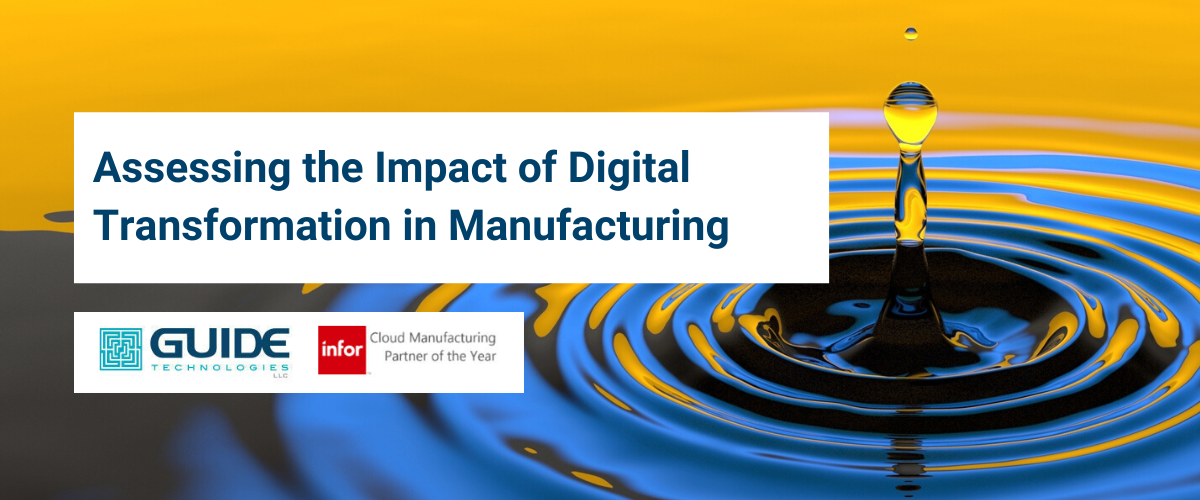January 30, 2020

Are We There Yet? How to Tell if Your Digital Transformation Is Working
Manufacturers have been pursuing digital transformation for a long time now. Sometimes it feels like a journey that will never reach its destination. That’s partly because it is. Since the goal of digital transformation is improvement, there is no true endpoint.
There are, however, some telltale signs that digital transformation is taking hold and driving change in your manufacturing business. If you’re looking around and wondering, “Are we there yet?”, here are six signs your digital transformation is on the right path. Follow this guide to help assess the impact of digital transformation in your manufacturing business.
1. Things are moving faster.
Welcome to the fast-moving world of digital, where there is a solution for every problem and always a better, faster, smarter way to do anything. Change comes fast and furious in the digital world, so if you feel like it’s a constant race to keep up, you probably are. But you’re in the race and not on the sidelines, that’s a great sign.
2. Your workforce is changing.
As your processes have changed and adapted to the digital era, your organizational structure and workforce have likely changed as well. Companies that embrace digital transformation attract top talent, younger Millennial and Generation Z workers, and those with specialties in new and different areas than you ever imagined exploring. Some departments will grow and others will shrink or shift into different areas. Where you once had to hire locally, you may now be building a more diverse workforce from all across the country. If your workforce is looking different these days, it’s a good sign your transformation has laid down some strong roots.
3. Your work culture is changing.
Digital transformation changes not only who you hire in manufacturing, but how they work across the enterprise. Cloud software in particular paves the way for greater flexibility in when and where work gets done, so you may have more remote workers working outside the standard 9-to-5 schedule. Changes in data administration and communication channels have likely changed how your divisions, departments, and teams collaborate. People who had to manually operate and observe machines and production lines are now free to move around the factory floor. People once stuck at their desks crunching numbers for reports all day can get out in the field. An office that once bustled with phone chatter and foot traffic may seem still and quiet in comparison as workers now use web tools to access and share information.
4. You spend less time “in the weeds”.
Automation relieves a lot of tedious, hands-on, gear-grinding work everywhere from the factory floor to the back office. That time can instead be spent on solving problems, making improvements, helping others, and coming up with new ideas. If your calendar seems more filled with meetings about strategy, process, and planning, it’s a great sign that you’ve turned an important corner in your digital transformation journey.
5. Your customers are happier.
When assessing the impact of digital transformation in manufacturing, it can be tempting to focus only on internal changes. Sometimes, though, the biggest impact is felt outside the enterprise by your customers. Digital transformation has a huge impact on quality, both in your products and your customer experiences. Success means setting and meeting high expectations and delivering personalized experiences. It doesn’t even have to feel revolutionary. Something as simple as account reps having a complete view of a customer’s contact information, product and shipping details, and order history in one place thanks to ERP data systems is a huge step forward.
6. Profits are up.
When the digital transformation of manufacturing hits its stride, there is one surefire way to tell if it’s working: look at your bottom line financials. Digital transformation should be supporting efficiency, reducing costs, increasing revenue, and driving profits. Consider your gains compared to the cost of your transformation efforts. Are you seeing a positive ROI on your ERP and other investments? That is a good indication that your digital transformation is thriving.
Driving Digital Transformation with Guide Technologies + Infor Solutions
Keeping your manufacturing digital transformation on course while also navigating day-to-day business isn’t easy. It helps to have an experienced hand to guide you in the right direction and help you keep your bearings. Guide Technologies can be that partner for you. As Infor’s 2019 Cloud Manufacturing Partner of the Year with over 20 years of manufacturing industry excellence, we can help you choose, implement, and maximize manufacturing software solutions that support your goals. We won't just help you with assessing the impact of digital transformation in manufacturing. We'll help you create the results you need. Contact us here.
Explore Infor Manufacturing Solutions for Digital Transformation

Infor CloudSuite Industrial (SyteLine) Overview
Get the facts about the fastest growing ERP system in the country. Developed by experts in discrete manufacturing, Infor CloudSuite Industrial (SyteLine) has more than 30 years of experience built in.
Infor CloudSuite (SyteLine) Brochure
Download the official Infor CloudSuite solution brochure for a closer look at features and specifications
Clash of the Titans 2019
Read an independent comparison of SAP, Oracle, Microsoft Dynamics and Infor ERPs.
Stay Up-to-Date! For the latest updates on cloud manufacturing solutions, ERP, and Infor news, follow Guide Technologies on LinkedIn, Twitter, or Facebook.
